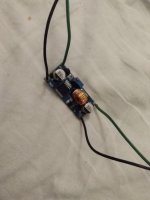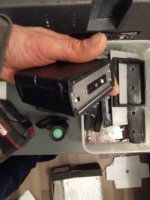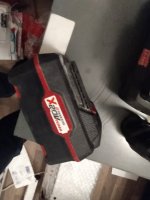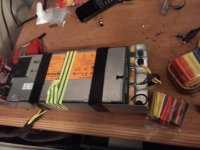Bad_rabbits
1 µW
- Joined
- Nov 20, 2019
- Messages
- 3
Hello all,
Firstly, thankyou for taking the time to read this. I hope you won't be offended by me posting here - there may well be other forums more suitable, however this has been the only forum I have been frequenting over the last year, I've grown greatly interested in the subject of homebuilt battery packs. I'm not an E-biker (yet) - my primary interest is has been in building large capacity powertool battery packs. Projects completed so far - zero.
I'm not completely ignorant when it comes to DC electricity, and thanks to this forum, have learnt a moderate amount about Li-ion batteries and pack building.
I have an old Thermal imaging camera that I am trying to make good. Essentially it needs a power source... and since my last accident, a new display - though this was always a planned upgrade.

The unit was originally powered by an 8.4v NiMH battery pack - the same variety as used in some Icom 2 way radios.
I understand that the NiMH pack provides a very linear source of power, and although replacement packs that took 10 x AA Batteries are also available (5S2P... Is my nomenclature correct?) - they are advised against due to the sensitive nature of the electronics.
To cut a long story short, I was planning to rebuild the enclosure for this camera, utilising a "Parkside" brand 18v nominal power tool battery as a power source. Not the ideal type of Lithium battery, In know (high discharge, relatively low capacity), but I have plenty knocking around. I also have a 3D printed adapter allowing me to mount it on the underside of the unit - and it just looks like it was meant to be there.
When bench testing I used a cheap 5a rated DC-DC adjustable Buck converter, model XL1405 to provide 8.4v from the Parkside battery. Something went horribly wrong.
I know that the camera doesn't pull anything like 5a, even on startup, so I can't imagine what the issue is. I tried a second XL1405 (Always buy cheap chinese stuff several at a time) and had the same issue. Everything checked out on the multimeter, but the camera didn't like it one bit. Distinct toasty smell.
Since then the CRT monitor/viewfinder has packed in.
Thankfully there is a BNC outlet included in the wiring, which I had always intended to use to rig up a higher resolution monitor - this particular 2nd Gen TIC is quite capable and the inbuilt CRT screen doesn't do it justice.
I have tried the XL1405 unit with a variety of power supplies and always get the same results. 12v SLA, 12VDC PSU...
I am able to run the camera for short periods using 12VDC. Since the accident in fact, a 9V power source doesn't seem to cut ther mustard. I'm slightly concerned about the long term damage that may have been caused here.
I feel like I must have made some rookie error, does anybody have any suggestions? Any thoughts whatsoever would be greatly appreciated.
View attachment 5

View attachment 3



Firstly, thankyou for taking the time to read this. I hope you won't be offended by me posting here - there may well be other forums more suitable, however this has been the only forum I have been frequenting over the last year, I've grown greatly interested in the subject of homebuilt battery packs. I'm not an E-biker (yet) - my primary interest is has been in building large capacity powertool battery packs. Projects completed so far - zero.
I'm not completely ignorant when it comes to DC electricity, and thanks to this forum, have learnt a moderate amount about Li-ion batteries and pack building.
I have an old Thermal imaging camera that I am trying to make good. Essentially it needs a power source... and since my last accident, a new display - though this was always a planned upgrade.

The unit was originally powered by an 8.4v NiMH battery pack - the same variety as used in some Icom 2 way radios.
I understand that the NiMH pack provides a very linear source of power, and although replacement packs that took 10 x AA Batteries are also available (5S2P... Is my nomenclature correct?) - they are advised against due to the sensitive nature of the electronics.
To cut a long story short, I was planning to rebuild the enclosure for this camera, utilising a "Parkside" brand 18v nominal power tool battery as a power source. Not the ideal type of Lithium battery, In know (high discharge, relatively low capacity), but I have plenty knocking around. I also have a 3D printed adapter allowing me to mount it on the underside of the unit - and it just looks like it was meant to be there.
When bench testing I used a cheap 5a rated DC-DC adjustable Buck converter, model XL1405 to provide 8.4v from the Parkside battery. Something went horribly wrong.
I know that the camera doesn't pull anything like 5a, even on startup, so I can't imagine what the issue is. I tried a second XL1405 (Always buy cheap chinese stuff several at a time) and had the same issue. Everything checked out on the multimeter, but the camera didn't like it one bit. Distinct toasty smell.
Since then the CRT monitor/viewfinder has packed in.
Thankfully there is a BNC outlet included in the wiring, which I had always intended to use to rig up a higher resolution monitor - this particular 2nd Gen TIC is quite capable and the inbuilt CRT screen doesn't do it justice.
I have tried the XL1405 unit with a variety of power supplies and always get the same results. 12v SLA, 12VDC PSU...
I am able to run the camera for short periods using 12VDC. Since the accident in fact, a 9V power source doesn't seem to cut ther mustard. I'm slightly concerned about the long term damage that may have been caused here.
I feel like I must have made some rookie error, does anybody have any suggestions? Any thoughts whatsoever would be greatly appreciated.
View attachment 5

View attachment 3





